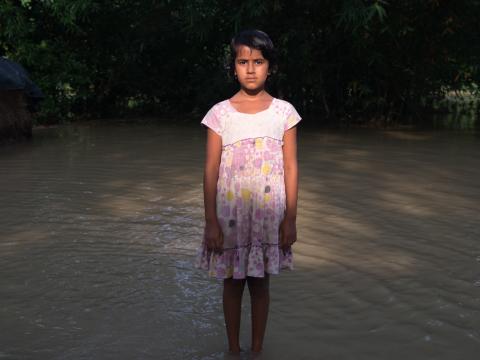India Floods: 12 Photos that you should see

By Daniel Mung, World Vision India Communications Officer
It's as if their lives don't matter at all.
They’re still in waist-deep water, their homes destroyed, their crops lost and their future threatened. Others have been hunkered in evacuation centres for weeks, waiting for the water to wash away, to claw back a life.
And no one outside their community seems to care.
For the last 15 days, families in West Bengal have been dealing with mass flooding.
Locals say it's the worst flooding in 15 years. There are an estimated 13,200 villages in just West Bengal alone affected, with the worst affected district being Bardhaman, where more than 333,000 people are directly affected. In all of India, an estimated 10 million are affected.
But it’s not on news stations. It’s not being discussed in public spheres. There’s no mention in newspapers. And I can’t figure out why.
For the last five days, I’ve taken tiny hand-dug boats to reach villages cut-off – their road access lost due to the rising waters.
I’ve been to relief camps set up to offer a dry place for the flooded. These centres are cramped and dingy – but they’re the only place that people can go.
There, children who have lost their clothes in the flood roam naked. There’s obviously a risk – particularly for girls’ safety – in these centres.
And there’s also a risk of child trafficking – families who have lost everything have told me they’re consider sending their children to work in the cities.
I’ve seen children desperate to go back to their shuddered school. Their school books had been swept away by the floodwater. Others were forced to abandon their exams – which threatened their academic future.
Another girl I met was forced to evacuate to her school. She called the experience of staying inside a classroom – while her home was submerged – ‘sad’. Schools were meant to be fun, enjoyable places, she told me, but now it would have a horrible memory.
I’ve met an 8-month pregnant women clinging to hope that the water will recede. She wanted to give birth anywhere but the relief camp her family was stationed. It was too crowded – there were 150 families sharing just one building. She longed to go home.
I’ve met families who have camped out on train platforms for weeks, as it’s the only place not underwater in their community. They’d set up make-shift tents, desperate to survive, while passengers catching trains hurried by, apparently untouched by the need at their footsteps.
I’ve listened to farmers who say they’ll have to abandon their fields and head to the city for work. They’re crops have been destroyed, their harvest – which offers an annual income – lost. The flooding is so extensive that many of the fields look like rivers now.
I’ve wished I could do something more than take their photo, to write a short quote. I am witnessing something horrific.
My only hope is that these images touch a few people who see them.
It’s exhausting mentally to be exposed to people suffering again and again and feeling like there’s little that can be done. Knowing that my photographs can bear witness and tell of the need is what keeps me going.
World Vision aims to provide emergency relief to 100,000 people. They are also looking at how to help farm families in the months to come – so that the lost harvest won’t mean the families collapse.
Please don’t ignore this. These families need help. Please give.
About the author | Daniel Gin Sian Mung weaves human interest stories through his pictures for World Vision India. He is based out of Delhi.